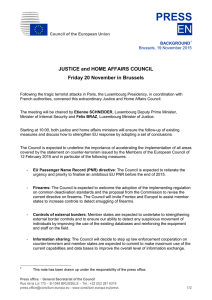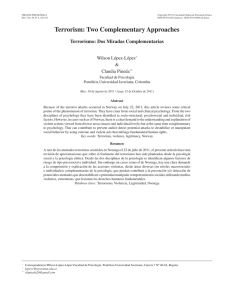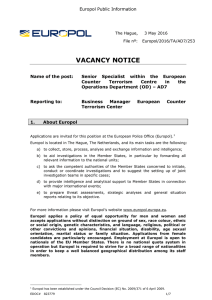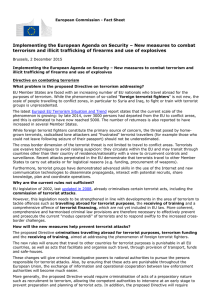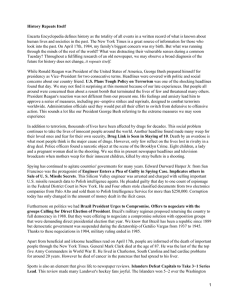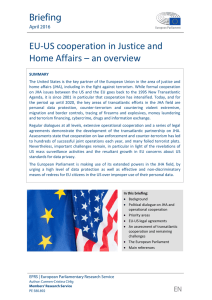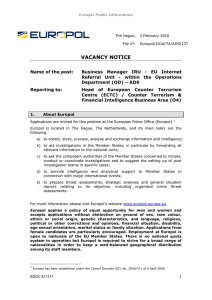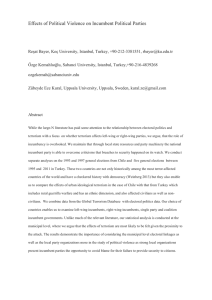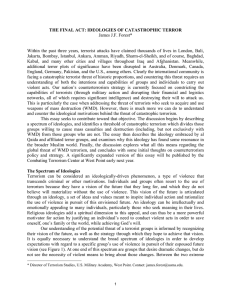Counter-terrorism funding in the EU budget
Anuncio
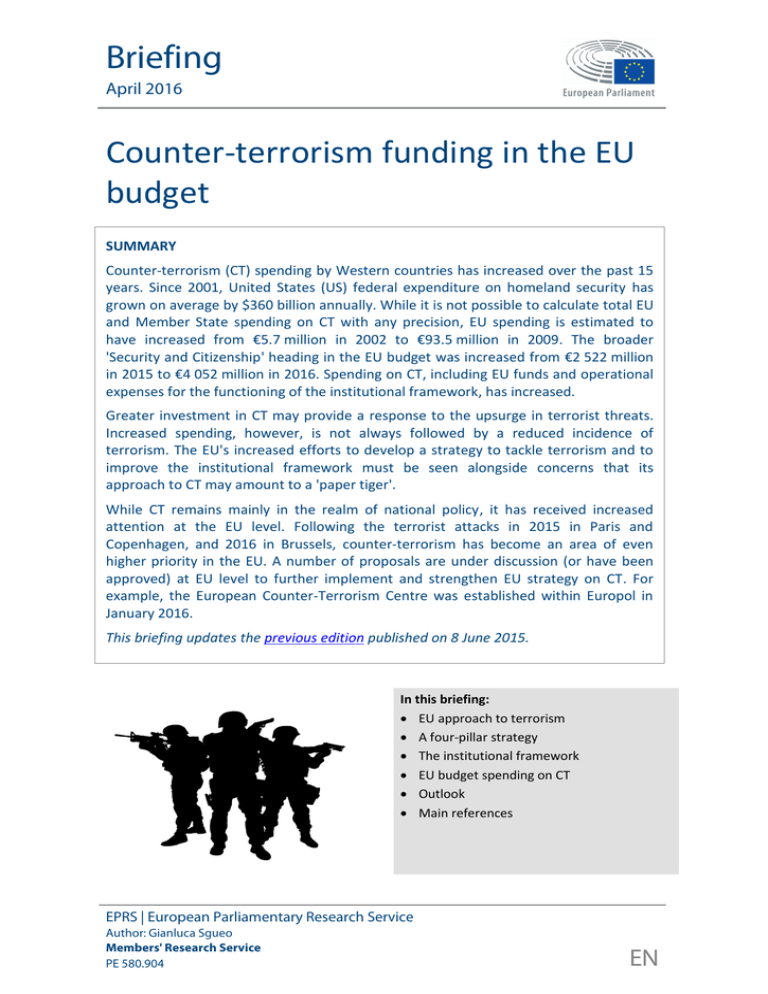
Briefing April 2016 Counter-terrorism funding in the EU budget SUMMARY Counter-terrorism (CT) spending by Western countries has increased over the past 15 years. Since 2001, United States (US) federal expenditure on homeland security has grown on average by $360 billion annually. While it is not possible to calculate total EU and Member State spending on CT with any precision, EU spending is estimated to have increased from €5.7 million in 2002 to €93.5 million in 2009. The broader 'Security and Citizenship' heading in the EU budget was increased from €2 522 million in 2015 to €4 052 million in 2016. Spending on CT, including EU funds and operational expenses for the functioning of the institutional framework, has increased. Greater investment in CT may provide a response to the upsurge in terrorist threats. Increased spending, however, is not always followed by a reduced incidence of terrorism. The EU's increased efforts to develop a strategy to tackle terrorism and to improve the institutional framework must be seen alongside concerns that its approach to CT may amount to a 'paper tiger'. While CT remains mainly in the realm of national policy, it has received increased attention at the EU level. Following the terrorist attacks in 2015 in Paris and Copenhagen, and 2016 in Brussels, counter-terrorism has become an area of even higher priority in the EU. A number of proposals are under discussion (or have been approved) at EU level to further implement and strengthen EU strategy on CT. For example, the European Counter-Terrorism Centre was established within Europol in January 2016. This briefing updates the previous edition published on 8 June 2015. In this briefing: EU approach to terrorism A four-pillar strategy The institutional framework EU budget spending on CT Outlook Main references EPRS | European Parliamentary Research Service Author: Gianluca Sgueo Members' Research Service PE 580.904 EN EPRS Counter-terrorism funding in the EU budget Glossary Terrorism: There is no agreed definition of 'terrorism' in the EU. The European Commission uses the definition provided by the International Organisation for Migration: 'the intentional and systematic use of actions designed to provoke terror in the public as a means to certain ends. Terrorism can be the act of an individual or a group of individuals acting in their individual capacity or with the support of a State'. Internal Security Strategy: Lays out a European security model that integrates, among other things, action on law enforcement and judicial cooperation, border management, and civil protection, with due respect for shared European values, such as fundamental rights (source: Council of the European Union). EU approach to terrorism Increased spending on counter-terrorism Spending on counter-terrorism (CT) by Western countries has increased over the past 15 years. Since 2001, for instance, the United States (US) increased federal expenditure on homeland security by an average of US$360 billion annually.1 According to analysis by Investopedia – a financial education website – using data sourced by the Stockholm International Peace Research Institute, following the January 2015 attacks, the French government increased CT spending by €3.8 billion for the coming four years. European Union (EU) spending on security matters (including CT) has also increased in recent years. In 2011, the European Parliament estimated that EU spending on CT had increased from €5.7 million in 2002 to €93.5 million in 2009. The same study estimated that EU spending in the area of freedom, security and justice had increased by 163% between 2006 and 2011 (even if only a small part of this was related to CT). While the heading 'Security and Citizenship' – as it was renamed under the 2014-20 Multiannual Financial Framework (MFF) – was slightly reduced from the 2014 to 2015 budget (from €2 172 million to €2 146.73 million), spending on CT has increased. For 2016, the EU has budgeted €4 052 million in commitments and €3 022 million in payments for security and citizenship. The literature suggests that terrorist threats and public spending on CT are linked in a cause and effect relationship.2 Political attention to CT has increased, following the recent rise of the Islamic State of Iraq and Syria (an Islamic extremist rebel group known as ISIL/Da'esh, which controls territory in Iraq and Syria), as well as the flow of jihadists in and out of various Middle Eastern theatres of war, and, albeit to a minor extent, the increase of left-wing and anarchist movements. Examples of this include calls for a common EU foreign and security policy, requests for strengthened human rights and (respect for the) rule of law in non-EU countries, and moves towards cooperation with non-EU bodies on CT-related issues. Increased spending on CT may also be explained as an attempt to provide credible answers to public concerns. Europol reports an increase in the number of terrorist acts in Europe in 2014, contrary to the trends in recent years. In 2014, a total of 201 terrorist attacks occurred in seven EU Member States – up from the 152 attacks reported in 2013 – while 774 individuals were arrested for offences related to terrorism – a number significantly higher than the 535 arrests reported in 2013. Public concern has also risen in recent years. The 2006 Transatlantic Trends Survey (TTS) reported that, for the first time, the number of Europeans who said they were concerned about terrorism had increased by eight percentage points in only one year.3 Since then, terrorism and security-related issues have remained top concerns in the annual TTS. Members' Research Service Page 2 of 8 EPRS Counter-terrorism funding in the EU budget In 2015, following the terrorist attacks in Paris, the French Council of the Muslim Faith recorded a 110% surge in reported 'Islamophobic' incidents. ThinkProgress reports that after the Paris attacks there were at least 69 incidents in which Muslims and nonMuslims were victims of shootings, threats, personal assaults, and vandalism of their places of worship. After the attacks in Brussels, #StopIslam trended on Twitter around the world. Far-right nationalist groups operating in the United Kingdom have started campaigns such as 'Christian Patrols', while in Germany the group Patriotic Europeans against the Islamisation of the West, or 'Pegida', was created in 2014, to oppose the alleged 'islamisation' of the Western world. Since 2014, many mosques in Europe have been under police protection.4 Increasingly, civil society networks advocate the respect of human rights and the rule of law in CT activities by EU Member States.5 EU progress in counter-terrorism While CT remains mainly in the realm of national policy, it has grown in relevance at EU level. The first EU actions in this area date back almost 40 years – the first platform for European cooperation on counter-terrorism, known as 'TREVI' (Terrorisme, Radicalisme, Extrémisme et Violence internationale), was created in 1976.6 Further steps towards cooperation in tackling terrorism at EU level include: the Schengen Agreement (1985), which abolished all internal borders between participating Member States and enhanced judicial and border cooperation; the Maastricht Treaty (1992), which reorganised justice and home affairs cooperation, including anti-terrorism efforts within a 'third pillar' and created the law enforcement agency Europol; the first EU Action Plan to fight terrorism (2001), which established a European Arrest Warrant and provided for a common definition of terrorist offences; the appointment of the EU's first Counter-Terrorism Coordinator (2004); and, finally, the adoption of the first overall counter-terrorism strategy (2005) and its updates (in 2008 and 2014). After the November attacks in Paris and the Brussels attacks, renewed EU action on CT has been demanded. New measures include a package of proposals presented by the European Commission to strengthen the management of the EU's external borders and protect the Schengen area. In March 2016, Justice Ministers of EU Member States agreed the Council's negotiating position for discussions with Parliament on the proposal for a directive on combating terrorism. Critical views of EU strategy While it is widely acknowledged that the EU has made important progress in CT, critics point to two major problems.7 The first of which, and the main one, is the lack of an overall framework when new measures to tackle terrorism are adopted at EU level. The causes of this problem are: firstly, that CT is not in itself a defined policy area, but one that spans a number of policy areas; and, secondly, that approaches towards CT may differ greatly at Member States level. In 2005, for instance, of 25 EU Member States, only five had ratified the 14 United Nations (UN) conventions related to terrorism. According to critics, the absence of an overall CT framework may hamper the effectiveness and durability of the decisions taken on this issue. The institutional structure designed to tackle terrorism is regarded as the second major problem related to CT. In part, Member States may occasionally have shown a reluctance to share information on terrorist activities, thus hampering the EU's efforts towards a coordinated response (this also partly explains the de facto limited role of Europol in CT-related issues). This well-known problem also exists at national level, illustrated by the Dutch government's 2005 'Bonfire' operation, involving a simulated Members' Research Service Page 3 of 8 EPRS Counter-terrorism funding in the EU budget terrorist attack at a concert. Lack of communication between public services emerged as one of the operation's main flaws. On the other hand, Member States still engage in informal arrangements to discuss security matters. This has led to a proliferation of informal bodies and networks concerned with anti-terrorism. A four-pillar strategy Approved for the first time in 2005, updated in 2008, and revised in 2014, the EU counter-terrorism strategy includes various measures to tackle terrorism, ranging from punitive to more proactive, such as the promotion of democracy, dialogue and good governance. This strategy is based on four pillars8 – prevention, protection, pursuit and response – introduced by the EU counter-terrorism strategy of 2005. The first and third pillars deal with external measures, while the second and the fourth focus on internal measures. This also helps to explain the uneven results. Most work has been done under the protection pillar, where in fact most of the activities are led by the European Commission. There have also been successful actions under the prevention pillar, owing to the increased relevance of Five waves of EU action Europol and Eurojust. The pursuit and response pillars have seen less activity. EU action in fighting terrorism may be The first pillar: prevention The prevention pillar's main goal is to prevent terrorism by identifying and countering methods from recruiting new terrorists, for instance, from among EU citizens who convert to Islam. A study by the Nixon Centre reveals that, of the 373 Muslim terrorists arrested in Europe and the US between 1993 and 2004, 41% were Western nationals, who had either been naturalised in the Western state or had converted to Islam. Many of the so-called 'foreign fighters', individuals who join insurgencies abroad for mainly ideological reasons, may also be EU nationals of similar profile.9 Since 2013, the 'foreign fighters' issue is a top priority for EU action under the prevention pillar.10 summarised in four waves: (1) 2001 – The EU's first action plan to fight terrorism was adopted within two weeks of the 9/11 attacks in New York; (2) 2004 – The first EU CounterTerrorism Coordinator was appointed after the March 2004 attacks in Madrid; (3) 2005 – The EU adopted its first overall counter-terrorism strategy after the July 2005 London bombings; (4) 2015 – The shocking Charlie Hebdo killings in Paris led to a new wave of activism to further enhance EU CT capabilities. (5) 2015/2016 – the further attacks in Paris, followed by those in Brussels, led to a push for stronger and faster EU action on CT. Under the first pillar, the EU not only coordinates national policies, but also helps to disseminate best practice and information/knowledge across Member States. Among the measures included under the prevention pillar is the promotion of democracy and education through assistance programmes, explaining European policies to the wider world, and the fostering of inter-cultural dialogue. The second pillar: protection The protection pillar has two goals: the first is to reduce the vulnerability of targets of terrorist attack; and the second is to limit the resulting impact of attack. The Schengen Information System and the Visa Information System (both aimed at improving border controls) are among the tools in place to protect against terrorism. Further instruments falling under the protection pillar include critical infrastructure protection, cybersecurity and the Passenger Name Record system now the subject of an agreement between the Council and Parliament but not yet adopted. Members' Research Service Page 4 of 8 EPRS Counter-terrorism funding in the EU budget The third and fourth pillars: pursuit and response The first goal of the pursuit pillar is to counter terrorism across borders (e.g. by cutting off access to materials and disrupting terrorist networks); the second is to eliminate sources of terrorist financing by carrying out inquiries, freezing assets and impeding money transfers (e.g. by tackling the misuse of funding to non-governmental organisations). The European Arrest Warrant, designed to bring perpetrators to justice, also falls within this pillar. The fourth pillar, response, aims to enhance response management mechanisms to be used in the event of a terrorist attack in a Member State. In this case, the Commission's contribution consists of facilitating the coordination of Member States' operations. The institutional framework A broad EU institutional framework covers CT issues and is composed of: EU bodies whose main tasks include countering terrorist threats; EU-level networks of professionals and experts in the field of security and defence; EU agencies; and a number of working groups and informal bodies operating at both EU and national level. A brief account of the most important bodies is given below. The EU Counter-Terrorism Coordinator The first EU Counter-Terrorism Coordinator (ECTC) was appointed in the immediate aftermath of the 2004 terrorist attacks in Madrid, initially with a limited budget and little scope for pushing legislation. The main role of the ECTC is to help governments to coordinate national CT policies. Over time, however, the role of the ECTC has increased, and the ECTC is now the EU's principal interlocutor on CT matters. At present, the ECTC's main tasks include coordinating the Council's work in combating terrorism, making policy recommendations to the Council, and monitoring implementation of EU CT strategy. Following the terrorist attacks in Paris and Brussels, the ECTC has taken part in the discussions on enhancing the EU's response on CT. In this vein, the ECTC has had several meetings with heads of state or government (including of Tunisia, Lebanon and the United States) to define common strategies on CT. The Radicalisation Awareness Network The Radicalisation Awareness Network (RAN) was established by the Commission in 2011. The network brings together more than 700 experts and practitioners from across Europe to facilitate the exchange of ideas. Since 2015 RAN has been particularly active in the field of radicalisation issues in prisons and prevention of radicalisation as an early CT strategy. Europol and Eurojust Europol was created in 1992; however, counter-terrorism was not included in its mandate until 1999. Between 2002 and 2009, Europol's budget increased from €53 million to €68 million. Europol's 2016 budget is over €100 million. In January 2016 a European Counter-Terrorism Centre (ECTC) was established within Europol. The ECTC is expected to become an information hub to help Member States to increase information-sharing and operational coordination. Created in 1999, Eurojust works to improve the coordination of investigations and prosecutions among the competent authorities in the Member States (particularly cooperation among prosecutors dealing with serious crimes). Eurojust's 2015 budget was nearly €34 million. Members' Research Service Page 5 of 8 EPRS Counter-terrorism funding in the EU budget Working groups Following the entry into force of the Maastricht Treaty, a number of working groups on terrorism were set up. In particular, the Working Party on Terrorism (COTER) within the Council of the EU, handles aspects of foreign policy related to terrorism, which fall under the EU's foreign and security policy. Following the November 2015 terrorist attacks in Paris, COTER has increased the frequency of its meetings to once a month. The Terrorism Working Group (TWG), also within the Council, deals with internal threat assessments and coordination among EU bodies. The Counter-Terrorism Group (CTG), created in 2001 independently from the EU, coordinates the work of intelligence heads, and cooperates closely with the EU. Other groups include the CP931 Working Party, made up of delegates from Member States' interior and foreign ministries, who deal with 'black lists' of suspected terrorists. The last meeting of the CP931 was in November 2015; and the ATLAS network, which ensures cooperation among EU special intervention units. Informal bodies A number of informal bodies have been created by Member States' government agencies to discuss security matters. One of these is the Club of Berne, which originated in the mid-1960s and brings together the heads of the European security agencies. A Counter-Terrorism Group (CGT) was later established within the Club of Berne. Other informal networks include the Police Working Group on Terrorism (PWGT), the Police Chiefs' Task Force (PCTF), and the G6 group (the interior ministers of France, Germany, Poland, Spain, Italy, and the UK). CT expenditure in the EU budget EU funding to tackle terrorist threats (as well as to secure freedom, security and justice) has evolved over the years. The 2007-13 MFF included a €140 million programme for the 'Prevention, Preparedness and Consequence Management of Terrorism and other Security-related Risks' (CIPS), designed to protect citizens and infrastructure from terrorist attacks. Under the 2014-20 MFF, the Internal Security Fund (ISF) is the financial instrument designed to support security-enhancing initiatives in the EU. The ISF is divided between: borders and visas; and police issues. The ISF has a €3.8 billion budget, of which only a small part goes to CT. More precisely, the 'ISF-Police' component of the ISF is aimed at ensuring security in the EU, including CT. For 2014-20, this instrument has a budget of €1 004 million (€662 million through shared management, where actions are carried out by the Member States, and €342 million through direct management by the Commission). EU spending on CT is not only through the ISF. A number of other sources of funds are spread across the EU budget. For instance, the Commission made €1.4 billion available for security research under the Seventh Framework Programme for Research (FP7) for 2007-13. The aims of the projects funded included the development of technologies and knowledge to enhance security against terrorist threats. Outlook In the 2007-2013 MFF, freedom, security and justice policies represented 1.25% of the EU budget. Over the years, however, the EU has set up new budget lines to promote studies and measures to enhance security. In the 2014-2020 MFF the heading 'citizenship, freedom, security and justice' represents 1.63% of the total EU budget. Members' Research Service Page 6 of 8 EPRS Counter-terrorism funding in the EU budget Since 2015, CT and its financial implications have become a high priority at international and EU level. In November 2015, G20 leaders adopted a statement on the fight against terrorism. Among the points stressed in the statement, the need to tackle terrorist financing is included. A number of proposals to amend the EU counter-terrorism strategy are listed in the resolution on CT adopted by the Parliament on 11 February 2015.11 Amongst the most recent EU efforts on CT, five are of particular importance. First and foremost is the use (for the first time) of Article 42(7) of the Treaty on European Union on bilateral assistance. The article establishes that the EU Member States have 'an obligation of aid and assistance by all means in their power' to any country that is 'the victim of armed aggression on its territory'. The request for bilateral assistance from Member States was filed by the French government in the aftermath of the terrorist attacks in Paris on 13 November 2015 and received unanimous support by EU defense ministers. Second is the establishment of the European Counter-Terrorism Centre, which is supposed to help information-sharing among Member States. Moreover, in December 2015, the European Commission presented a package of proposals to protect the Schengen area. One of the proposed modifications aims at obliging Member States to carry out systematic checks against relevant databases on all persons at external borders. The Council agreed its negotiating position on the proposed regulation in February 2016. In February 2016, the Council adopted conclusions on the action plan to strengthen the fight against terrorism financing. A month later, in March 2016, the Council's negotiating position on the proposal for a new directive on CT was approved by Justice Ministers of EU Member States. The proposed directive – to be negotiated with the European Parliament – would criminalise preparatory acts such as training and travel abroad for terrorist purposes, and reinforces rules on the rights of the victims of terrorism. Main references A. Beugelink, Screening of the European Council statement of 12 February 2015 on relevance for the EU budget. R. Bossong, The action plan on combating terrorism: a flawed instrument of EU security governance, Journal of Common Market Studies, 46:1, 2008, pp. 27-48. O.E. Danzell, S. Zidek, Does counter-terrorism spending reduce the incidence and lethality of terrorism? A quantitative analysis of 34 countries, 29:3, 2013, pp. 218-233. European Parliament, Directorate-General for Internal Policies of the Union, Policy Department C, Estimated costs of EU counterterrorism measures, 2011. Europol, Te-Sat 2014. European Union terrorism situation and trend report 2014, 2014. M. Wesseling, Evaluation of EU measures to combat terrorism financing, European Parliament, Directorate-General for Internal Policies of the Union, Policy Department C, 2014. Endnotes 1 J. Mueller, M.G. Stewart, Terror, Security, and Money: balancing the risks, the costs of homeland security, Oxford, p. 211. 2 O.E. Danzell, S. Zidek, Does counter-terrorism spending reduce the incidence and lethality of terrorism? A quantitative analysis of 34 countries, 29:3, 2013, p. 218-233. 3 M. Ramzan Shahid, Threats of Terrorism in Europe, Journal of European Studies, 28:02, 2012, p. 87-105. Members' Research Service Page 7 of 8 EPRS Counter-terrorism funding in the EU budget 4 European Union Agency for Fundamental Rights, Reaction to the Paris attacks in the EU: fundamental rights considerations, FRA paper 01/2015. For a comprehensive overview of religious fundamentalism and radicalisation, See European Parliamentary Research Service, Religious fundamentalism and radicalisation, 2015. 5 See for instance the 2016 joint civil society statement by the World Organisation Against Torture. 6 A. Teasdale, T. Bainbridge, Trevi Group, The Penguin Companion to European Union (2012). 7 R. Coolsaet, EU counterterrorism strategy: value added or chimera?, 86:4 International Affairs, 2010, 857-873; D. Kehoane, The EU and counter-terrorism, Centre for European reform working paper, 2005; R. Bossong, The action plan on combating terrorism: a flawed instrument of EU security governance, 46:1 Journal of common Market Studies, 2008, 27-48; B. Muller-Wille, The effect of international terrorism on EU intelligence co-operation, 46:1 Journal of Common Market Studies, 2008, p. 49-73. 8 Not to be confused with the (three) pillars into which, under the 1992 Maastricht Treaty, the EU's action was organised. 9 See P. Bakowski, L. Puccio, 'Foreign fighters' – Member States' responses and EU action in an international context, European Parliament Research Service, February 2015; T. Hegghamer, Foreign Fighters under International Law, Geneva Academy of International Humanitarian Law and Human Rights, 2014. 10 European Council strategic guidelines for legislative and operational planning within the area of freedom, security and justice. See also Council Framework Decision 2002/275/JHA on combating terrorism, amended by Council Framework Decision 2008/929/JHA. 11 The resolution emphasises three points: 1) Review of existing law enforcement measures: a case in point is the finalisation of the EU Passenger Name Record Directive, another is revision of the European Arrest Warrant. A 2013 assessment found that between 2005 and 2009, almost three quarters (43 059) of the incoming warrants between 2005 and 2009 were not executed, resulting in an estimated cost of €215 million. 2) Strengthening of the network of information shared about terrorism (for instance, by creating a European counter-terrorism platform within Europol, to guarantee that all relevant data are shared within the EU , and not simply held by a Member State). 3) Adoption of an external EU strategy to combat international terrorism, forged through dialogue between experts in security and development. Disclaimer and Copyright The content of this document is the sole responsibility of the author and any opinions expressed therein do not necessarily represent the official position of the European Parliament. It is addressed to the Members and staff of the EP for their parliamentary work. Reproduction and translation for noncommercial purposes are authorised, provided the source is acknowledged and the European Parliament is given prior notice and sent a copy. © European Union, 2016. Photo credits: © Oleg_Zabielin / Fotolia. [email protected] http://www.eprs.ep.parl.union.eu (intranet) http://www.europarl.europa.eu/thinktank (internet) http://epthinktank.eu (blog) Members' Research Service Page 8 of 8
